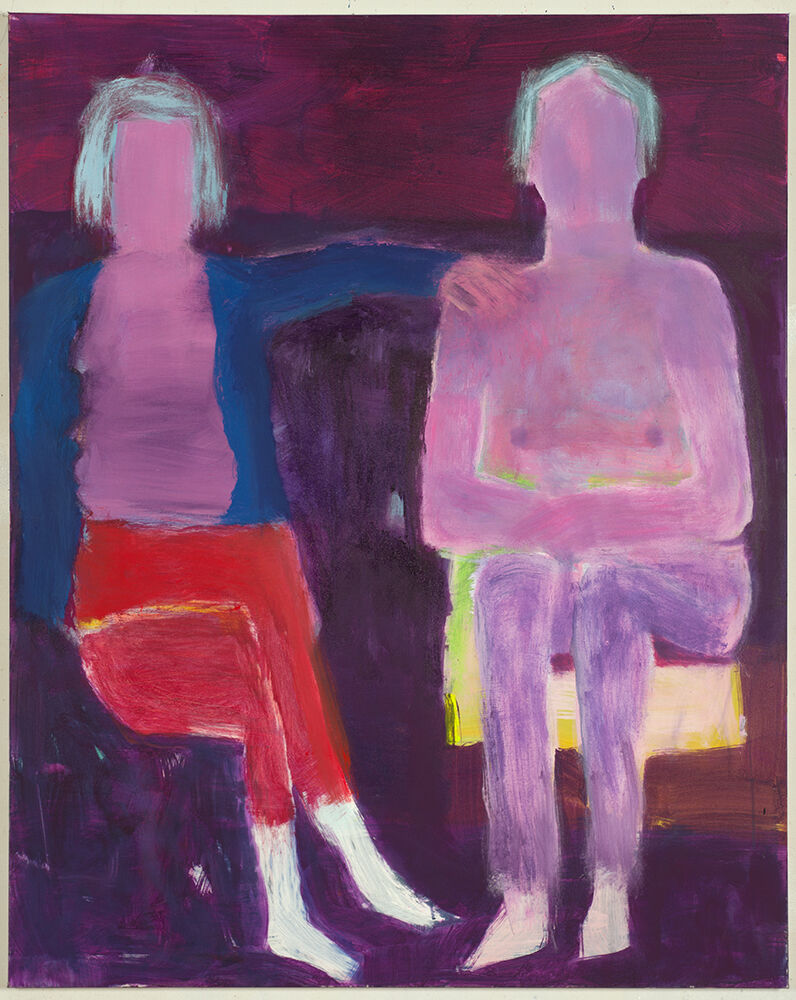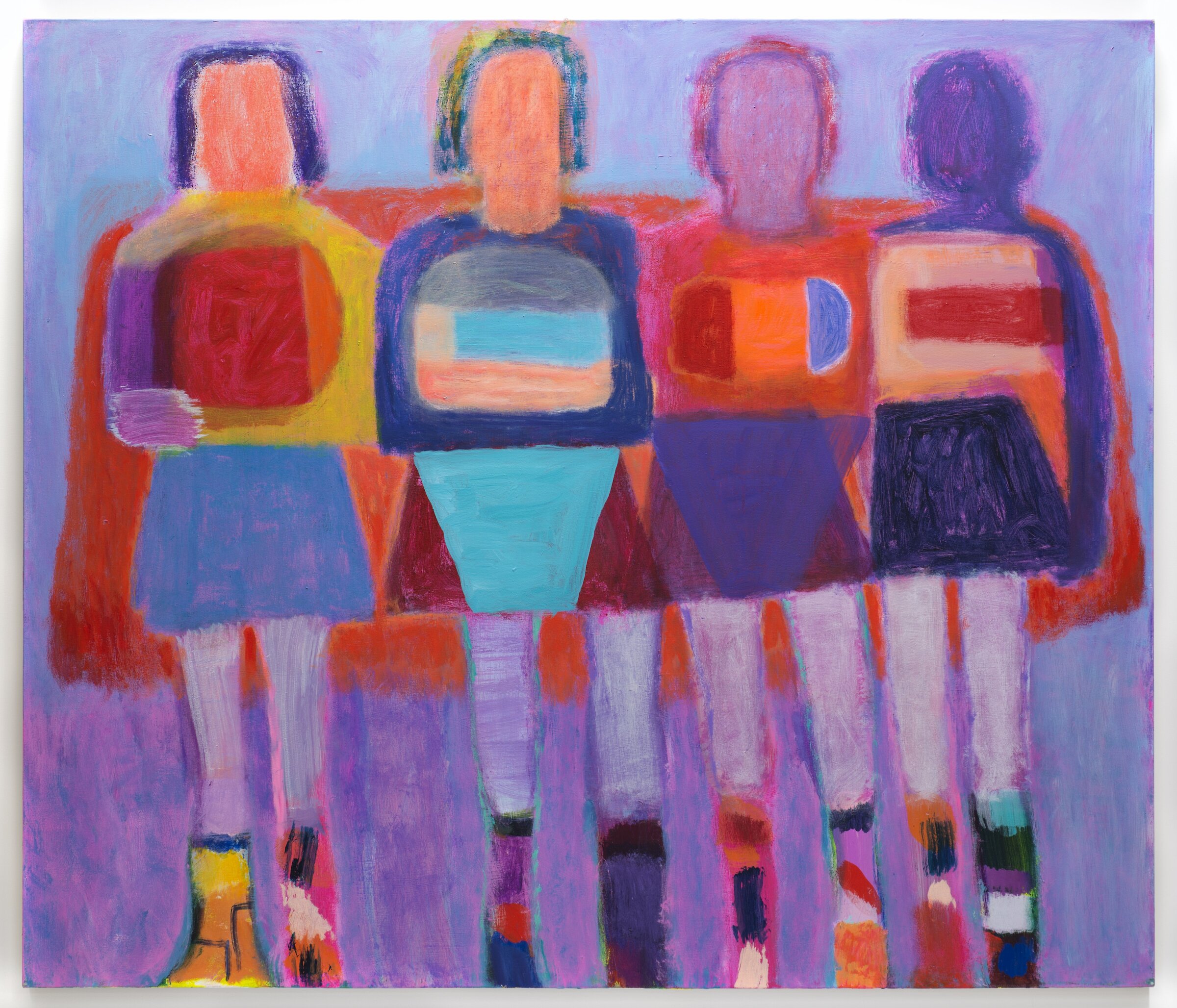Hall 1 [1-11]

Katherine Bradford, Couple No Shirts, 2018
Acrylic on canvas, 152,4 x 121,9 cm
Courtesy Jerry Speyer, New York

Katherine Bradford, Superheroes, 2020
Acrylic on canvas, 172,7 x 203,2 cm
Courtesy J.J. Murphy & Nancy Mladenoff, New York
The grand hall of HALLE FÜR KUNST shows works from various New York collections made by Katherine Bradford since 2015. Featuring motifs central to the artist, such as superheroes, everyday heroes and rather indeterminate figures, she represents diverse communities and their individuals.
Bradford’s figures assume the most diverse positions; perspective is either completely absent or strained. On the one hand, Bradford fabricates mystical, dream-like scenes, but, on the other hand, she is always inspired by her immediate surroundings and everyday situations. In her depiction of communities, she is at all times concerned with the interaction of bodies: both their congregation and their mutual avoidance or evasion. What is interesting in terms of her arrangements of portraits and communities is the ever-changing technique of painting, as if the content itself is influencing her style.
In Couple No Shirts (2018) [7], two larger-than-life, seated bodies stare at the viewer from a frontal, head-on perspective. Their faces have no features; eyes, mouth and nose are completely missing. With pink to purple limbs, red, blue and white clothes and green hair, the figures are set against a dark purple background. These rich applications of color reveal influences from traditions of Color Field Painting, abstract expressionism, and artists such as Mark Rothko. However, while the historical protagonists of Color Field Painting avoided any differentiation between background and foreground, or any figurative delineation, Bradford subverts this trope by integrating one (or more) figure(s) into her compositions.
Bradford’s distinguished and unmistakable style arises from the interweaving of the abstract and the figurative, and is most strongly embodied through her characters. Subtle variations in gesture and size, and with unexpected exaggerations of form through lengthening or thickening of limbs are characteristic features of the artist’s practice. Similar to Henri Matisse’s interiors, Bradford uses this variable compression or enlargement of proportion to create striking illusions of space on a two-dimensional surface.
The indeterminacy of the bodies also confronts the viewer with questions of identity. Due to the lack of facial features and other characteristics which could represent gender, it is almost impossible to categorize the protagonists’ identity. Hence, Bradford deliberately destabilizes the boundaries of constructions such as gender in a new way thus forming a direct visual contribution to progressive and contemporary feminist debates, according to which gender is understood as fluid.
Superheroes (2020) [5] is another contribution to a feminist debate in a broader sense, depicting superheroes, whose gender is not implicit. Bradford establishes a counter-visuality to a male-dominated art history and historiography, which also prevails in concrete public space in the form of monuments and statues. Bradford depicts superheroes of various stripes who mutate into a somewhat humorously forced heroine status under a common cloak. Instead of endorsing tropes of superheroes as lone warriors, she thereby suggests that through communities, individuals can be empowered and strengthened. Moreover, in this painting the assumption of masculinity implied by the word “hero” becomes ambiguous and universal.
It was in the early 1990s that Bradford began painting male superheroes. Initially, those superheroes were more akin to comic characters, and thereby proposing a subtle ridicule of the cult of the hero. Against this background, her series of androgynous and feminine superheroes and superwomen—which she started to paint shortly after the taunted supermen — can be interpreted as asserting a political agenda.
Due to exaggerated proportions and rich flat planes of color, Bradford’s characters also suggest a monumentality. Thereby, Bradford depicts her understanding of a democratic community. However, as the exhibition makes clear, Bradford’s work is not about the embodiment of monumental individual heroes, but about the depiction of individuals in diverse communities, in which every life story is both relevant and interesting. In this way, Bradford’s oeuvre offers an essential perspective to contemporary debates and disputes about the architectural occupation of public space: akin to monuments and memorials, art also contributes significantly to the collective memory of a nation and a society.
In addition to the oversized figures in her 2021 paintings, Bradford has made monumental mosaics entitled Queens of the Night as public art on the L Train Line at the First Avenue and Bedford Avenue stations in New York, further underlining her intention to rewrite memory culture and art history in a feminist, intersectional and inclusive way.
Although Bradford may not intend to be understood in an explicitly political sense, but rather wants her images to speak for themselves in all their diverse and forward-looking power, her visuality stands in the tradition of enlightenment and progressive interpretations.
[1]
Water Lady, 2018
Acrylic on canvas
203,2 x 172,7 cm
Courtesy Susan & Michael Hort, New York
[2]
Writers, 2019
Acrylic on canvas
203,2 x 172,7 cm
Courtesy Beth Rudin DeWoody, New York
[3]
Women under Stars, 2022
Acrylic on canvas
182,9 x 152,4 cm
Courtesy Susan & Michael Hort, New York
[4]
View from Below, 2020
Acrylic on canvas
203,2 x 172,7 cm
Courtesy Private Collection, New York
[5]
Superheroes, 2020
Acrylic on canvas
172,7 x 203,2 cm
Courtesy J.J. Murphy & Nancy Mladenoff, New York
[6]
Stripe Twins, 2019
Acrylic on canvas
152,4 x 121,9 cm
Courtesy Susan & Michael Hort, New York
[7]
Couple No Shirts, 2018
Acrylic on canvas
152,4 x 121,9 cm
Courtesy Jerry Speyer, New York
[8]
Friends Together, 2024
Acrylic on canvas
121,92 x 91,44 cm
Courtesy Katherine Bradford, New York
[9]
Bus Stop, 2021
Acrylic on canvas
182,9 x 152,4 cm
Courtesy Matthew Astrachan and Janna Haroche, New York
[10]
Man in Tub with Legs, 2018
Acrylic on canvas
152,4 x 182,9 cm
Courtesy Susan & Michael Hort, New York
[11]
Mme Matisse, 2018
Acrylic on canvas
203,2 x 172,7 cm
Courtesy Susan & Michael Hort, New York